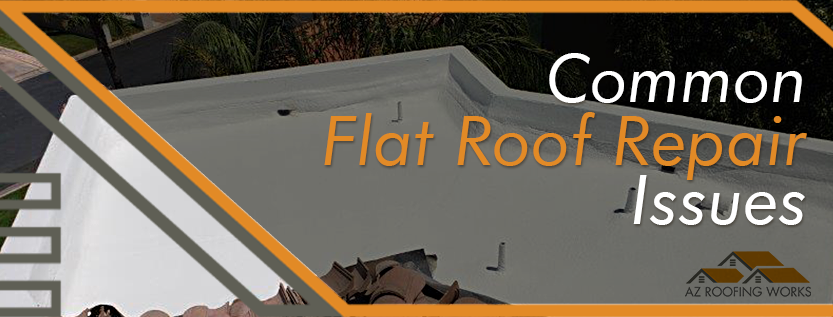Common Flat Roof Repair Issues
Are you wondering whether now is a good time to get your roof checked?
The answer is yes, if for no other reason than to avoid paying more later down the road.
There are several reasons for that.
Of course, as issues on a roof linger, they get worse.
Also, the roofing market is seeing increased demand and is feeling tariff pressures.
Both forces will drive up the price of a roof for consumers.
So, call your roofer now to talk flat roof repair and extend the life of its surfacing and try to avoid picking up a big bill for a new roof from untreated damage.
But what problems would they help with?
What should you be looking for to make sure things stay kosher?
Here are a few things to look out for.
Ponding Water Means Problems
While this isn’t directly an issue that requires specific repair, it is a symptom of needed repairs.
Water is not supposed to stay on the flat roof surfacing.
There are two reasons for this.
The practical reason is that most flat roofs aren’t’ truly flat, which allows water to flow off.
The proactive reason is that pooling or ponding water is the first step in what could be a cascade of potential problems.
No matter what the material, rainwater will contain pollution, dust, organic matter or any combination of nasty stuff that will degrade your roof surface.
Ensuring that water doesn’t pool and the ice doesn’t dam up water flow its important to preventing leaks and extending the life of your roof.
There are a whole list of reasons why water is pooling on your roof. None should be taken lightly.
Here are a few of the most common.
Blocked or Damaged Outlets
If you live in an area with any foliage, your roof outlets may eventually get blocked up with debris from trees or anything else that can blow on the wind.
Lost balls and frisbees can also cause blocked outlets.
Checking your roof regularly will help ensure you prevent pooling damage from blocked outlets.
Poor Pitch
Unless your flat roof has the right pitch, the issues with ponding and poor flow out of outlets will be constant.
As your building settles, the pitch of your roof will change and cause issues with pooling.
Cuts and lacerations are as serious for a roof as they are for your body.
The bigger the slice in the membrane, the greater the likelihood of major damage.
Also, the worse a slice is, the greater the skill that’s needed to appropriately repair the damage.
Lacerations and Cuts
These happen in storms with high winds where debris is moving, with foot traffic, overhanging trees and by slips of the hand.
Buckling Materials
Houses age like people. Things start to shift and sag.
For roofs, shifting and sagging frames or decking cause shallow indentations in the roof that causes the pooling mentioned earlier.
These can be fixed with tactical additions of material.
But, eventually, adding new to old won’t work.
Flat roof repair for bucking might require actually replacing the roof to account for the shifted structure or replace worn-out material.
Shrinkage
This happens in heat, not just in the cold.
This is especially true for EPDM roof surfaces. In roof areas with inconsistent or poor seals, the material will pull back from roofs, walls, or other intrusions on the roof.
This is an issue that can usually be remedied with a repair patch.
It can be prevented with covering with a light ballast to help regulate heat absorption and loss.
Ballast can also help keep help large uninterrupted segments from shifting.
Punctures
The reasons why don’t really matter.
A puncture in a flat roof surface means water can make intrusion into the roofing structure.
Or, and even more worrisome, the water could permeate through the roofing material, causing gradual roof-wide water damage.
Luckily, these are usually easy patch jobs. But, unfortunately, it’s not until a leak spring that the puncture lets itself be known.
Have a certified professional assess your flat roof repair needs.
Membrane Blisters
When air or water gets in ton an area that is poorly adhered to the roof, a blister will pop up.
As it’s heated, the air and water push more forcefully on the membrane. This repair takes a trained hand not to make worse.
Often these membrane blisters come from shoddy installation work.
If you have one that bubbles up, the odds are that another will bubble up somewhere else.
Alligatoring
This is common on bituminous roofs.
This happens when constant sunlight causes the rubbery materials in the roof to tighten and lose elasticity.
Just like the name suggests. It makes the roof membrane look like alligator skin.
These must be remedied quickly. While the alligatoring membrane might not have failed yet, the crinkled surface means that it is near failure.
It can be fixed without a massive repair if the damage is not widespread.
Algae and Fungus
Simple lifeforms like this often grow in areas of shade.
This is where the water and cool make life more hospitable than the heat.
These patches of scum can make the membrane surface slippery and, therefore, unsafe.
Further, prolonged mold and fungus exposure can lead to a lot of the issues mentioned above.
Flat Roof Repair Takes Skill
All of these issues are or can lead to serious issues for your roof.
It takes a flat roof repair pro to make sure issues are remediated appropriately.
A well-installed roof will last for decades.
But to get the most out of the lifespan of your flat roof, little bits of damage must be fixed immediately.
Reach out to us today to discuss your roofing needs.
Are you looking for a trusted roofer in Mesa that can handle your flat roof? Call the pros at AZ Roofing Works for a Free Roofing Estimate or call our office directly at (602) 283-3383.






